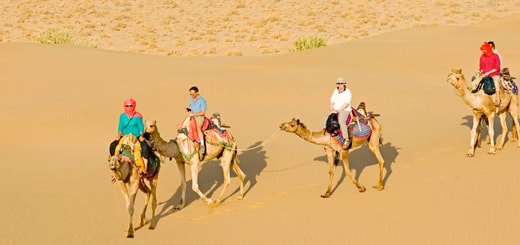
BY Admin
Rajasthan’s desert, the Thar Desert,is spread across two nations: India and Pakistan. The desert is bordered on the four sides by the Rann of Kutch in the south, plains of Punjab in the north and the northeast, Aravalli ranges in the south and the Indus plains in the west. The Thar covers an area of about 77000 sq. miles. The Thar Desert is considered as one among India’s five physical divisions, the others being the Himalayas, the Northern Plains, the Central Plateau, and the Eastern and Western Coastal Plains. The Thar Desert covers the area that lies in the north and north western parts of Rajasthan. Thar also touches other states in India namely, Punjab, Gujarat and Haryana. Physical Characteristics of the Thar Desert Vegetation and Animal Life For the tourists to Rajasthan, their trip is never complete without a ride on the desert camels of Thar. The sunsets on the Thar are sights that should not be missed at any cost. Thesewill surely make up for a memorable holiday.
It consists of stretches of sandy plains interspersed sand dunes and small barren hills. The sand dunes keep moving and appear in different sizes and shapes. However, some of the older dunes that have stabilized are of a height of almost 500 feet. One can find lakes in the midst of the Thar that have saline water. These are called dhands in the local parlance. The rainfall is very sparse and erratic in the region. The west gets less rainfall (100 mm) than the eastern regions (500 mm) of The Desert. The maximum rainfall in the desert regions occur during the period between July and September in a year.
The vegetation in this part of the country consists of bushy and stunted shrubs sporadically interspersed with trees. Acasia gum trees and khajri trees (Prosopis Cineraria) can also be found. The gazelle and the Black Buck are some animals which can be found here. Some of the birds that inhabit this region are the Great Indian Bustard, the quail and the francolin. Geese and Sand Grouses are some birds that touch this part of the world during their migration.
Your email address will not be published. Required fields are marked *
